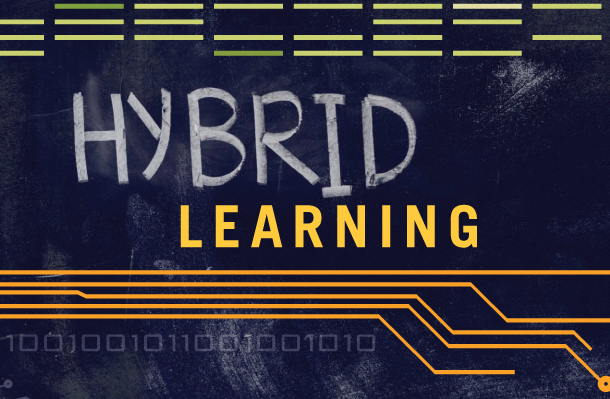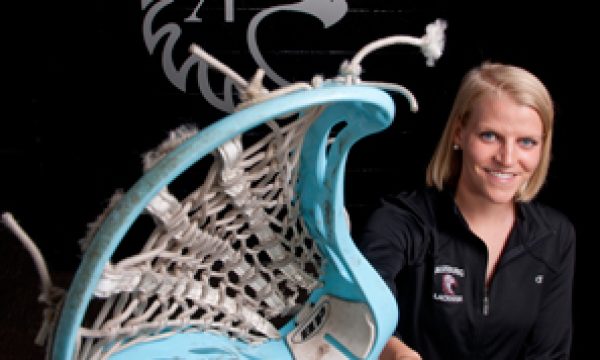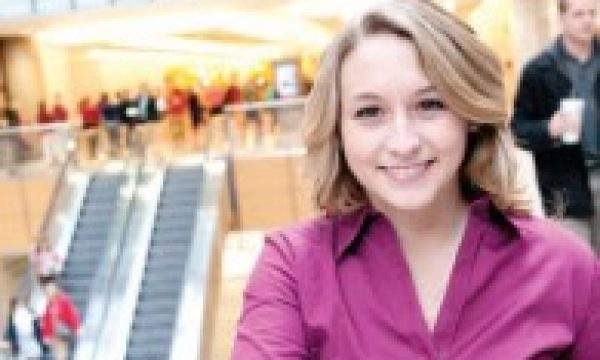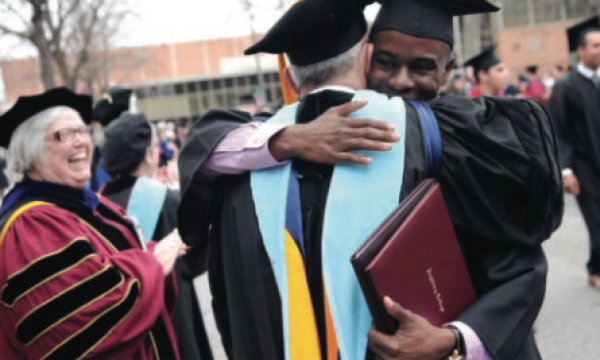
For Lisa Benjamin ’06, ’12, the possibility of going back to school was appealing, but finding time to spend in a classroom was challenging.
In 2010, Benjamin sought a license to teach in Minnesota and to sharpen her skills in American Indian student instruction—a field she has been passionate about since her youth. But, like many of Augsburg’s non-traditional learners, Benjamin had the busy schedule and family responsibilities of a working adult.
That’s why a unique Augsburg College program that takes advantage of the strengths of both classroom and web-based learning environments—called hybrid or blended learning—offered an ideal opportunity. Courses delivered in a hybrid format combine traditional face-to-face components and online learning activities to optimize student engagement.
“I thought the Augsburg program was a perfect match for what I was working toward,” Benjamin said. “I liked the fact that a partially online course meant I didn’t have to go into school every weekend or every day. My son was 3 years old, and I didn’t want to be away from him all the time.”
By taking advantage of the strengths of a hybrid program structure, Benjamin met her teaching licensure goal and joined a tight-knit community.
“The other students were a remarkable, supportive group of people,” she said. “I got to learn from them and their experience.”
The effectiveness of hybrid learning
Augsburg historically has offered only select hybrid classes. However, beginning this fall, the College will expand the number of courses offered in a blended format.
Augsburg will launch a hybrid instruction model for a significant number of graduate and adult undergraduate courses at its Minneapolis and Rochester campuses, shifting approximately half of students’ course contact time to a web-based format. Students in these blended courses will follow a schedule in which in-classroom meetings and online instruction alternate every other week.
Augsburg already employs a variety of approaches to hybrid instruction, and the proportion of in-class versus online course contact time varies from program to program based on student demographics. For example, Augsburg’s Master of Arts in Leadership and Master of Fine Arts in Creative Writing programs offer a low-residency schedule in which one- or multi-week intensive face-to-face sessions are paired with online coursework completed throughout the term.
The new initiative to expand hybrid program offerings with an every-other-week format is based on recommendations made following multi-year studies through which faculty, staff, and administrators identified how the College could best further its tradition of delivering high-quality, face-to-face instruction; integrate technology into programs for non-traditional students; align with the changing demands of the adult education market; and satisfy federal education regulations.
“Much of the inspiration for this work stems from the opportunity we identified as an institution to enhance the way we serve our students,” said Lori Peterson, assistant vice president and dean of graduate and professional studies.
Peterson, who chaired a task force on academic program structure, said the College is taking a thoughtful approach to integrating online elements into teaching and learning. “Our faculty and curriculum committees have done tremendous work to ensure quality in our blended learning approach and to identify the ways in which we will achieve the highest level of learning outcomes,” she said.
By shifting additional academic programs to a hybrid format, the College will meet the needs of current and future non-traditional learners. A 2010 U.S. Department of Education analysis of online-learning studies concluded that hybrid courses were at least as good if not marginally better and more engaging than a fully online model.
“Many organizations are finding out that, where possible, combining face-to-face meetings with work in an online environment increases student satisfaction, student learning, and retention when compared to a course that’s offered solely online,” said Dan McGuire, an education and communication specialist who is working with the College as the project manager for a hybrid teaching and learning transition team.
Nationally, 6.7 million higher education students took at least one online course in 2011, accounting for nearly one-third of all such students. These figures, released in the 2012 Survey of Online Learning, detail those classes in which at least 80 percent of the course content was delivered online, but schools offer online learning in varying degrees—including a web-facilitated instruction model with few online elements as well as the blended learning model Augsburg selected.
Non-traditional students 21 and older constitute the majority of online learners. Frequently, adult students prefer to take courses online or to have some combination of an online and a face-to-face format because it affords greater flexibility as the students juggle full- or part-time employment, family commitments, and other obligations while attending school.
By implementing a hybrid model for adult students, “Augsburg is retaining the power of its physical community—of a social, spiritual place that exists within a long, vibrant history—and is fusing the educational tradition of the College with an effective teaching and learning system,” McGuire said.
A college-wide endeavor
Rolling out a new academic program structure is an effort that requires diligence, commitment, and coordination. In order to offer adult undergraduate programs in a hybrid format, Augsburg faculty and staff for almost a year have worked to re-conceptualize and redesign face-to-face classes so that content can be presented through online course management software.
Often times, students in hybrid courses master more basic material online at their own pace so that the classroom becomes a place where the application of that knowledge can be refined through lab experiments and discussions with peers or the professor.
The online component in Augsburg’s hybrid courses will be delivered through Moodle, a website in which educators create micro-sites for each unique course. Augsburg has used Moodle since 2005 and selected this learning management system because the platform is “grounded in sound teaching principles,” according to Scott Krajewski, director of information technology.
Moodle is recognized for supporting activities common in a classroom, and it “provides an elegant structure to ask and answer questions, to present information, and to engage in an educational community in between meeting times,” McGuire said. “The beauty of Moodle is that it’s a very powerful tool—all of the different variations of interacting with students have been thought through.”
According to Krajewski, Augsburg faculty and staff are working in collaboration to design the hybrid courses and to implement best practices for teaching online. Members of Augsburg’s information technology staff are certified in online course design and are experts at tailoring classes so that they “best match the institutional mission as well as the needs of distinctive academic departments, course sections, and students.”
By the end of May, nearly 200 faculty members had begun the process of converting adult undergraduate courses for fall 2013 into a hybrid model, and their work continues this summer. Together, faculty and staff members will convert approximately 300 unique courses into a new format—tasks that McGuire said require a time commitment ranging from 10 to 40 hours per class.
Developing high-quality hybrid courses requires sufficient time for planning, designing, developing, and testing. Moodle then allows professors to maximize the productivity of the in-class portion of their instruction and to use innovative, multimedia elements online. In contrast to an in-person course with minimal supplementary material, the instructor and students in a hybrid course interact with each other online—they engage in discussion, complete activities, and consume entirely new information in textual, visual, and auditory formats.
Susan O’Connor, associate professor of education, has been teaching in a hybrid model for the past five years and served as a co-instructor for Benjamin’s teaching licensure program. O’Connor found that while she initially was hesitant to instruct online, she quickly realized the benefits of the new format. “It turned out to be one of the best teaching experiences of my career,” she said. “This teaching method calls students to take more ownership in their learning, it offers a lot more freedom of time around their schedules, and it sharpens the objectives that they need to fulfill during each class session.”
Benjamin found that the blended learning model pushed her to be specific and clear in her written communication and to master course content by approaching assignments at her own pace.
“I feel like the program helped me in my career and served the K-12 students I work with,” she said. “I was challenged, but at the same time it was possible for me to be a mom, to be a student, and to have a full-time job.”




